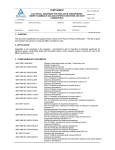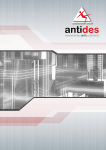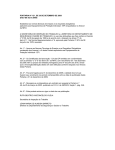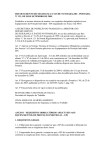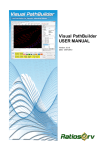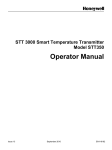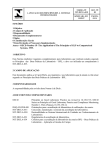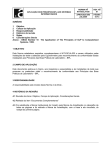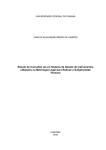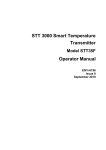Download ESTATUTO SOCIAL
Transcript
COMPLEMENT Doc. 704-CRC-014-ELT Revision: 05 SAFETY CERTIFICATION HOUSE APPLIANCES AND SIMILAR Pages: 1/15 Created by: Fabio Sora de Araujo Verified by: Karen Carolina Martins Approved by: João Damião Date of Approval: 24/07/2015 1. OBJECTIVE Establish criteria for the Program for Conformity Assessment of household and similar appliances, with a focus on safety requirements, through the mechanism of certification, meeting the requirements of INMETRO Decree No. 371/2009, ABNT NBR NM 60335 or IEC 60335-1 -1 - General Requirements and Particular Requirements of the rules of the standard series ABNT NBR NM 60335-2 or IEC 60335-X-2-X applicable to the product, aiming to prevent consumption accidents and protect consumers in relation to electrical, mechanical, thermal, fire hazards and radiation of appliances when in normal use. 2. RESPONSIBILITY The responsibility for the review of these requirements for the Granting and Maintaining License to use the mark for the SBAC (Brazilian Conformity Assessment Program), henceforth treated as a "requirement" is from TÜV Rheinland do Brasil Ltda. 3. ADDITIONAL DOCUMENTS • ABNT / ISO / IEC Guide 2: 1998 Standardization and Related Activities - General Vocabulary • ABNT NBR ISO/IEC 17065 Requirements for bodies certifying products, processes and services. • ABNT NBR 5426:1985 Sampling Plan and procedures on inspection by attributes. • ABNT NBR ISO 9001:2008 Quality Management Systems Requirements • INMETRO Decree No. 27/2000 Low voltage fixtures for residential use • INMETRO Decree No. 179/2009 Rules for use of Trademarks, Symbols Accreditation, Recognition of Conformity to the Principles of Good Laboratory Practices - BPL and Inmetro Identification Mark. 4. DEFINITIONS For purposes of this requirement, we use the definitions of standard ABNT NBR NM 60335-1/2006 60335-1/2006 and IEC and the ABNT NBR 11829, ABNT NBR IEC 60335-2 / X, NM IEC 60335 - 2 / IEC 60335-2 X / X (see Section 2.1), besides the definitions of 4.1 to 4.5. 4.1 Product Packaging Package containing the product for commercialization purpose to the final consumer. 4.2 Manufacturer Legal entity that develops manufacturing transformation of the regulated product. production, creation, construction or 4.3 Family Set of products manufactured in the same factory, which serve the same function and that necessarily fulfill the following conditions: - Have the same basic design (in common parts or assemblies essential for safety) in terms of: applied technology, and mechanical characteristics of plastic and metal materials used in the methods of fixing, finishing and insulation; -The models differ in the electrical characteristics of nominal input (127 V or 220 V) and the use of secondary or accessory functions. 4.4 Lot Set of appliances of the same family, already manufactured, defined and identified by the Applicant. COMPLEMENT SAFETY CERTIFICATION HOUSE APPLIANCES AND SIMILAR Doc. 704-CRC-014-ELT Revision: 05 Pages: 2/15 4.5 Applicant Manufacturer or importer of the regulated product, which is requiring the Authorization for the Use of Identification of Compliance Mark, can be the manufacturer itself. 5. ACRONYMS • ABNT - Brazilian Association of Technical Standards • Cgcre - General Coordination for Accreditation of Inmetro • CNPJ - National Register of Legal Entities (Tax ID Number) • IEC - International Electrotechnical Commission • Inmetro - National Institute of Metrology, Standardization and Industrial Quality • ISO - International Organization for Standardization • MoU - Memorandun of Understanding (MoU) • NBR - Brazilian Standard • NM - Mercosul standard • OAC - Conformity Assessment Body • OCP- Product Certification Body • RAC - Conformity Assessment Requirements • ILAC - International Laboratory Accreditation Cooperation 6. Conformity Assessment Mechanism The mechanism of conformity assessment used in this requirement is the compulsory certification. This provides a choice between 02 (two) different systems for obtaining and maintaining the Authorization for using the Conformity Identification Mark: the certification with testing and evaluation of the Quality Management System registration (item 6.1) and the certification by lot (item 6.2). All stages of certification systems provided herein, shall be conducted by TÜV Rheinland do Brasil Ltda. 7. STEPS IN THE PROCESS OF CONFORMITY ASSESSMENT 7.1. Model with Assessment of the Quality Management System Fabrication and Testing 7.1.1. Initial Assessment 7.1.1.1. Analysis and Documentation Request 7.1.1.1.1. TÜV Rheinland do Brasil Ltda. analyzes the request and notify the necessary documentation, including at least: • Family composition and the similarity between models; • Lists of components and their suppliers, informing those already certified; • electric schemes; • assembly drawings or photographs of products and subassemblies; • User manual; • Identification labels; • Design, Final Drawaings, or photos of individual packaging. • Technical documentation of printed circuit boards (where applicable); 7.1.2. Initial Audit After examination and approval of the application and documentation, TÜV Rheinland do Brasil Ltda, in agreement with the applicant, schedule the performance of the initial audit for the Quality Management System of the manufacturer and collect samples at the factory in order to carry out all initial tests. COMPLEMENT SAFETY CERTIFICATION HOUSE APPLIANCES AND SIMILAR Doc. 704-CRC-014-ELT Revision: 05 Pages: 3/15 Note: the presentation of Certificate of Quality Management System issued under the SBAC, with reference to ISO 9001, and being this certification valid, exempts the holder from the evaluations of the Quality Management System under these Rules, while the same have validity. In this case the holder of the certificate must provide to TÜV Rheinland do Brasil Ltda. all the records from this certification. 7.1.3. Initial tests 7.1.3.1. TÜV Rheinland do Brasil Ltda. must collect representative samples of the manufacturer's production line, as defined in the Plan of Tests to achieve the initial tests for each of the families of products characterized. The sample must be identified, sealed and sent to the test. The sample must attend to the requirements for the tests performance established in the standard, general and particularly, applicable to the product. If Additional samples are required, TÜV Rheinland do Brasil Ltda. should make a new collection. When TÜV Rheinland do Brasil Ltda. perform the specimen collection, they shall prepare a sampling report, detailing the location and conditions under which the sample was obtained. Note: In case of prototypes, the manufacturer can collect and forward the sample to the TÜV Rheinland do Brazil Ltda by agreement between them, and under the responsibility of TÜV Rheinland do Brazil Ltda. The approval of the prototype in the initial tests does not release TÜV Rheinland do Brasil Ltda. to validate the products after the initial operation of the production line. 7.1.3.2. The samples should be tested and verified as specified Test Plan set by TÜV Rheinland do Brasil Ltda., in a testing laboratory. 7.1.3.3. If the test results present non-conformities with the standard requirements, TÜV Rheinland do Brasil Ltda. must request new tests, after correction of the causes which leaded to the failure of the product. If there is failure in one part of a product and this interfere in this same building as a whole, TÜV Rheinland do Brasil Ltda. should determine that the modified product is subjected to all tests prescribed by the general and particularly standard applicable to the product. Otherwise, only the tests should be performed whose results are affected by the change, being responsibility of TÜV Rheinland do Brazil Ltda to decide. 7.1.3.4. It is the responsibility of TÜV Rheinland do Brasil Ltda., based on analysis of different construction types, accessories and / or variations / models allowed within the family, to set the Test Plan to be undertaken, according to the standards applicable for the product as well as the number of samples to be collected. 7.1.3.5. The Test Plan shall be considered complete type test, according with the general rule and its particular standard, the sample of the equipment that represents the more complete configuration and the worst of the family. 7.1.3.6. Variations / models within the family, where there is significance for safety, must be verified on representative samples of these variations / models, in the tests relevant to those features of variation. 7.1.3.7. Variations should be considered: the nominal data input and output layouts, insulation systems, power supplies, use of engines, systems / components under pressure, components / systems for heating, mass, volume and others. 7.1.3.8. Further testing guideline, to be applied when there component relative to the base model, according to the following sequence: Compressor / motor 8, 10, 11, 13, 15, 16, 19 *, 21, 22, 23, 24 *, 27, 28, 29, 30 * Thermostat 8, 11, 13, 15, 16, 21, 22, 23, 24 *, 27, 28, 29, 30 * Pressure valve 8, 10, 11, 13, 15, 16, 19 *, 21, 22, 23, 24 *, 27, 28, 29, 30 * Plastic Cabinet 20, 21, 22, 23, 30 Switch 8, 11, 13, 15, 16, 21, 22, 23, 24 *, 27, 28, 29, 30 * Fan 8, 10, 11, 13, 15, 16, 19 *, 21, 22, 23, 24 *, 17, 18, 19, 30 * are differences in COMPLEMENT SAFETY CERTIFICATION HOUSE APPLIANCES AND SIMILAR Doc. 704-CRC-014-ELT Revision: 05 Pages: 4/15 Cabinet 8, 11, 13, 15, 16, 20, 22, 25 Resistor 8, 10, 11, 13, 15, 16, 19, 21, 22, 23, 27, 28, 29, 30 * Ballast 8, 10, 11, 13, 15, 16, 19 *, 21, 22, 23, 27 *, 28, 29, 30 * Transformer 8, 10, 11, 13, 15, 16, 17, 19, 21, 22, 23, 27, 28, 29, 30 * Printed Circuit Board mounted with its components 10, 11, 13, 15, 16, 19, 29, and 30 * * = applicable if the component is not certified under the SBAC 7.1.4 Issuance of Certificate of Compliance 7.1.4.1. The issuance of the certificate of conformity and Authorization for the Use of the Mark of Conformity Identification should only be granted to the applicant, after consolidation and approval of trials and audits, as well as other requirements. 7.1.4.2. A technician that wasn’t participate of certificate process of TÜV Rheinland do Brasil Ltda., based on the analysis of information given in stages, should give its opinion on the recommendation of certification. TÜV Rheinland do Brasil Ltda. must issue the certificate and provide guidance to the manufacturer and the applicant regarding the use of the Mark of Conformity Identification. 7.1.5 Maintenance Evaluation 7.1.5.1 Maintenance Audit 7.1.5.1.1. Periodic assessment of the Quality Management System registration must be done annually, after the granting of authorization for using the Mark of Conformity Identification and there may be extraordinary audits where there are reasons for this. 7.1.5.2 Maintenance Testing It is the responsibility of TÜV Rheinland do Brasil Ltda., based on analysis of different types of construction, accessories and / or variations allowed within the family, define the testing of each standard applicable to the product, as the test plan maintenance to be performed annually, in their samples to be collected, having as reference the date of grant of Authorization for the Use of the Conformity Identification Mark. 7.1.5.2.1 The maintenance test should be performed each year in different models from those that form a family, when it is formed by more than one model, should not be used the same model to perform all assays annual maintenance. 7.1.5.2.2. TÜV Rheinland do Brasil Ltda. can provide testing services for periods less than 12 (twelve) months if warranted by changes in production processes or complaints about the product. 7.1.5.2.3 Tests shall be performed in laboratories. 7.1.5.2.4. Tests for annual maintenance shall include all items of the standard (general and specific) for at least a model that represents a family. 7.1.5.2.5. Additional tests for other models may be required, when there is voltage variation feeding, leaving it to the TÜV Rheinland do Brasil Ltda. its definition, as established Test Plan, but at minimum shall include the following items standard: 7-10-11-15-16-19-23-25. 7.1.5.2.6. The sample should be collected randomly from each family of certified products, in the production, in the distribution center and in trade, alternately, seeing that it should be possible to perform the in each of the chosen product all the tests provided for the year. This choice is made by TÜV Rheinland do Brasil Ltda., without the prior knowledge of the manufacturer, as established in the Plan of Tests. This collection provides the sample for evidence testing, and counter-proof and witness test, all belonging to the same manufacturing lot. Samples of counter-proof and witness test and, at the discretion of TÜV Rheinland do Brasil Ltda., may remain with the manufacturer / importer as trustee and must be sent for testing in case of failure of the COMPLEMENT SAFETY CERTIFICATION HOUSE APPLIANCES AND SIMILAR Doc. 704-CRC-014-ELT Revision: 05 Pages: 5/15 sample used in the test of evidence. 7.1.5.2.7. Found some non-conformities in any of the maintenance test, it should be repeated in the two samples and characterized as counter-proof and witness, to non conformity attribute, not being allowed the observation of any non-conformity. Note: If TÜV Rheinland do Brasil Ltda finds appropriate, and in accordance with the manufacturer, the non conformity could be confirmed without the tests in the counter-proof and witness samples. 7.1.5.2.8. When confirmation of non-compliance, TÜV Rheinland do Brasil Ltda. immediately suspend the authorization for using the Mark of Conformity Identification, and their family, asking the manufacturer indicated treatment, with the definition of corrective actions and deadlines for implementation. Note: If the non Compliance found do not endanger the safety of the user, under analysis and responsibility of TÜV Rheinland do Brasil Ltda., a manufacturer may not have suspended its authorization to use the Mark of Conformity Identification, if shows to TÜV Rheinland do Brasil Ltda, through corrective actions, the implementation of the corrective actions in line for the entire family of products. 7.1.5.3 Routine Tests 7.1.5.3.1. Routine tests for quality control of the product are the responsibility of the manufacturer and should be performed in 100% of production, in the complete product. 7.1.5.3.2. Records of these tests should be kept for verification of TÜV Rheinland do Brasil Ltda., in the process of Initial Audit and the Audit of Maintenance. 7.1.5.4. Issuance of Certificate of Compliance Maintenance 7.1.5.4.1. The issuance of the certificate of maintenance of compliance and maintenance of Authorization for the Use of the Mark of Conformity Identification should only be granted to the applicant, after consolidation and approval of trials and audits, and any other requirements of items 7.1.5.1 , 7.1.5.2 and 7.1.5.3. 7.1.5.4.2. TÜV Rheinland do Brasil Ltda., based on the analysis of information given in the process stages, should give its opinion on the recommendation of maintaining certification. TÜV Rheinland do Brasil Ltda., must issue the certificate and provide guidance to the manufacturer and the applicant regarding the use of the Mark of Conformity Identification. 7.1.6 Handling deviations in the process of conformity assessment 7.1.6.1. Where there are found non-conformities results, TÜV Rheinland do Brasil Ltda. will issue a non-conformity report. 7.1.6.2. The manufacturer with the review and approval by TÜV Rheinland do Brasil Ltda., should do the proper treatment of these non-conformities. 7.1.6.3. Should be considered the impact of non-conformity in safety and the need to perform or not, the withdrawal of non-conforming products from the market. 7.2 Lot Certification System For the system with Lot Evaluation, the Authorization for Use of Conformity Mark Identification is tied only to the lot of manufacture / import valued, not being allowed processes to maintain the Authorization for Use of Conformity Mark Identification. 7.2.1 Type Tests for Lot COMPLEMENT SAFETY CERTIFICATION HOUSE APPLIANCES AND SIMILAR Doc. 704-CRC-014-ELT Revision: 05 Pages: 6/15 7.2.1.1. It is the responsibility of TÜV Rheinland do Brasil Ltda., based on analysis of different types of construction, accessories and / or variations allowed within the family, based on standards set for the product, define the Plan Type Tests to be conducted in the respective samples be collected. Type tests are performed on the samples twice prescribed as necessary for the testing of evidence. counter-proof and witness tests are not performed. 7.2.1.2. Type tests for the lot shall not submit non-conformities. In the event of non-conformity, is not allowed to remove samples from the lot. 7.2.1.3. The collection of samples for type tests for the lot, should be carried out by TÜV Rheinland do Brasil Ltda. 7.2.1.4. If the test results present non-conformities with the requirements of the general and particular standards applicable for the product, the request must be rejected. Having failure of a model, the entire lot will fail. If TÜV Rheinland do Brasil Ltda. do not consider all the requirements attended for granting authorization for the use of Conformity Mark Identification, the applicant company must be informed with the aspects for which the request was denied. 7.2.1.5. Type tests specified in the certification system for each lot should be performed in test laboratories. 7.2.2 Additional Testing Inspection Lot 7.2.2.1. In addition to the type tests for the lot, we should perform the tests for inspection lot. The collection of samples for testing inspection lot shall be carried out by TÜV Rheinland do Brasil Ltda. 7.2.2.2. It is the responsibility of TÜV Rheinland do Brasil Ltda., based on analysis of different construction types, accessories and / or variations allowed within the family, set in relation to standards for the applicable in the product, the Test Plan inspection to be conducted in the respective samples to be collected, considering the tests described in paragraphs 7, 8, 10, 16, 20, 22, 25, 27 of the general and particular standards. 7.2.2.3. The number of samples to be tested should be determined according to ABNT NBR 5426, with normal sampling plan, general inspection level I and EQS of 0.25. 7.2.2.4. Tests conducted inspection lot shall not present non-conformities. In the event of non-conformity is not possible to remove new samples of the lot. In this case TÜV Rheinland do Brasil Ltda., must inform the applicant aspects for which the request was denied. 7.2.2.5. Tests of inspection provided for in the lot by lot certification system should be performed in test laboratories. 8. Treatment of Complaints (Complaints Handling) The supplier must have a system for handling complaints from customers, including the following requirements, depending on the specifics of the program object: 8.1 A Policy for Handling of Complaints, signed by its greater executive, which demonstrates that the company: a) Values and give effective treatment to complaints submitted by its customers; b) Knows and undertakes to comply with and be subject to the penalties provided in the laws (Law No. 8078/1990, Law No. 9933/1999, etc.). COMPLEMENT Doc. 704-CRC-014-ELT SAFETY CERTIFICATION HOUSE APPLIANCES AND SIMILAR Revision: 05 Pages: 7/15 c) Examine critically the results and take the appropriate steps, according to statistics on complaints received; d) Defines responsibilities regarding the handling of complaints; e) Undertakes to answer any complaint forwarded by Inmetro within the deadline established by it. 8.2 Development of training program for the person or team responsible for handling complaints, as well as for the others involved, covering at least the following topics: regulations a) management; and product standards, processes, services, people or systems b) Understanding the Laws of 8078 of 11 September 1990, which provides for consumer protection and other measures, and 9933 of 20 December 1999, which provides for the powers of Conmetro and Inmetro, establishing the rate of metrological services, and other matters; c) Understanding of interpersonal relationships; d) Policy for Handling of Complaints; e) Procedure for Handling of Complaints. 8.3 Where relevant, separate facilities and easy access for customers who wish to make complaints, as well as signposts and posters encouraging complaints and reporting on how and where to complain; 8.4 Procedure for Handling of Complaints, which must include a simple form of registration of complaint by the client as well as screening, investigation, response, resolution and closure of the complaint; 8.5 Proper records of each of the complaints received and processed; 8.6 Map that allows to easily view the status (eg under review, progress, current status, resolved, etc.) for each of the complaints from customers over the last 18 months; 8.7 Statistics which show the number of claims raised in the last 18 months and the average time for resolution; 8.8 Conducting biannual review of statistics on the complaints and evidence of implementation of the corresponding corrective actions, as well as opportunities for improvements. 9. Identification of the Mark of Compliance The Mark of Conformity Identification, aims to indicate the existence of an appropriate level of confidence that the products are conform to the stipulations of this requirement. 9.1 Product Marking and Packaging 9.1.1. The appliances shall bear the mark of conformity in the product identification and packaging of each product, according to that described in Appendix A, which must be legible and indelible. 9.1.2. Besides the Conformity Mark Identification, the product must bear a legible form of identification, permanent and indelible, containing the code or the product family, with the explicit description of each model and the markings required by the rules, general and particular, applicable to the product. 10. Authorization for Use of Conformity Mark Identification Authorization for use of the Mark of identification Compliance will be granted when completing the steps described in this requirement. COMPLEMENT SAFETY CERTIFICATION HOUSE APPLIANCES AND SIMILAR Doc. 704-CRC-014-ELT Revision: 05 Pages: 8/15 The issuance of the Statement of Compliance and Authorization for the Use of the Mark of Conformity Identification and its use in products, not transfer, in any case, the liability of the company authorized to Inmetro and/or TÜV Rheinland do Brazil Ltda. 10.1 Grant of Authorization The granting of authorization shall contain, necessarily, the following data: a) name, trade name, complete address and CNPJ the requestor, or importer, if its not the applicant, apart from the same manufacturer's data; b) full details of TÜV Rheinland do Brasil Ltda., including name, registration number and signature of TÜV Rheinland do Brazil Ltda; c) Number of Authorization for the Use of the Mark of Conformity Identification, date of issue and validity of the License; d) identification of types and models of products covered with the respective design codes and relevant technical standards, belonging to one family; f) if you need more than one page, or use an attachment, they must be uniquely identified, referring to correspondence in the numbering and coding certificate. If the certificate has any type of attachment, the certificate must contain the words "accompanied only valid Certificate (s) of attachment (s)." g) Lot identification, in the case of mandatory assessment of conformity of the lot. 10.2 Maintenance of Authorization for use of the Mark of Conformity Identification The validity of the certificate of conformity and the maintenance of the Authorization for Use of Conformity Mark Identification are conditioned to the absence of non-compliance during the Evaluation of Maintenance, as defined in this requirement . 10.3 Suspension or Termination of the use of the Mark Identification Compliance 10.3.1. The suspension or cancellation occurs when not attended any of the requirements of Section 7.1.5.4. 10.3.2. In case of cancellation of the certification process, TÜV Rheinland do Brasil Ltda. should schedule a special audit to verify and register the following requirements: • When was the last production batch manufactured and in what quantity; • Material available in stock for new productions; • Quantity of finished product in stock and which licensed the company's forecast for this batch is consumed; • If the requirements of this have been completed since the last follow-up audit. 10.3.3. Once completed the above steps, TÜV Rheinland do Brasil Ltda. notifies the cancellation to Inmetro. 10.4 Misuse of the Authorization for Use of Conformity Mark Identification 10.4.1. TÜV Rheinland do Brasil Ltda. must control the use of the Mark of Compliance Identification in the product or company documentation is not leading to message mistake to the recipients. 10.4.2. In particular, it is improper use of certification, ie the use of the Mark and Certificate of Conformity Identification: • When the certification has not yet been granted yet or has been terminated; COMPLEMENT SAFETY CERTIFICATION HOUSE APPLIANCES AND SIMILAR Doc. 704-CRC-014-ELT Revision: 05 Pages: 9/15 • When the certification has been suspended; • In reference to products not covered by certification. 10.5 Waiver 10.5.1. The Company may waive the certification if the product is discontinued and is bound to: • Forward to TÜV Rheinland do Brasil Ltda. document signed by their legal guardian or anyone designated by him, stating his decision; • Restoring and no longer use the Product Certificate of Compliance; • Do not use more of the Conformity Mark Identification; • Destroy all advertising material that makes reference to the certification or the identification of the Mark of Conformity Identification 10.5.2. TÜV Rheinland do Brasil Ltda. must, on the resignation, establishes the applicable items 10.3.2 and 10.3.3. 10.6 Reconsideration If the Company wishes to reconsider the cases of resignation, suspension or cancellation, it must refer to the TÜV Rheinland do Brasil Ltda., in terms of less than 06 (six) months of the resignation or cancellation, the document signed by the custodian of the Company or his nominee appointed, stating the reasons that led to the present condition, and what the company has done to change this condition. 11. Responsibilities and Obligations 11.1 For the Authorized Company 11.1.1. Comply with all conditions of the general and particular provisions in the laws and contractual arrangements regarding the authorization, regardless of their transcription. 11.1.2. Comply with the relevant decisions taken by the certification TÜV Rheinland do Brasil Ltda., using, ultimately, to Inmetro in cases of complaints and appeals. 11.1.3. Facilitate TÜV Rheinland do Brasil Ltda., through proof of this condition, the work of auditing and monitoring, as well as other testing and certification activities under this requirement. 11.1.4. Maintain technical and organizational conditions that formed the basis for obtaining the Authorization for the Use of the Mark of Conformity Identification. 11.1.5. Prior notice to the TÜV Rheinland do Brasil Ltda. any change in its structure that would imply a change in product or production process, the model certificate. 11.1.6. The applicant must notify TÜV Rheinland do Brasil Ltda. when they plan any process change or modification in the product, so that the TÜV Rheinland do Brasil Ltda. can evaluate whether or not to perform tests or audits. 11.1.7. Promptly notify TÜV Rheinland do Brasil Ltda. in the event of termination, ultimately, the manufacture, import or marketing of the model certificate. 11.1.8. Keep the certified products with encryption (code and model) different from encoding of noncertified products. 11.1.9. Submit previously TÜV Rheinland do Brasil Ltda. all advertising material which is marked a COMPLEMENT SAFETY CERTIFICATION HOUSE APPLIANCES AND SIMILAR Doc. 704-CRC-014-ELT Revision: 05 Pages: 10/15 Conformity Mark Identification. 11.1.10. Bear directly with technical responsibilities, civil and criminal liability for products manufactured or imported by him, as well as all documents related to certification, with no possibility of transferring this responsibility. 12. Penalties In case of failure to comply with the requirements laid down by this, the companies permitted to use the Conformity Mark Identification will be subject to the penalties provided herein. Failure to satisfy the requirements included in this will lead to the penalties provided for in Article 8 of Law No. 9933 of th December 20 1999. 13. Use of Testing Laboratory 13.1 The tests described in the certification system as defined in Chapter 7 of this with the Exception for routine tests should be performed in laboratories of 3rd part accredited by Inmetro for the scope of the tests referenced. 13.2. Exceptionally and precarious, since it depends upon an evaluation by TÜV Rheinland do Brasil Ltda., it can be used non-accredited laboratory for the specific scope, when a set of assumptions described below: I. When there is no laboratory accredited by Inmetro for the scope of conformity assessment program at the time of enactment of the Decree for the program; II. While there are only one laboratory accredited by Inmetro and TÜV Rheinland do Brasil Ltda. show that the price of the analysis of non-accredited laboratory, plus the costs of the evaluation by TÜV Rheinland do Brasil Ltda., compared with the accredited laboratory to be at least lower than 50%; III. When the (s) lab (s) accredited (s) by Inmetro do not attend in at most two months the deadline for the start of the tests laid down in regulations. Note: The assessment carried out by TÜV Rheinland do Brasil Ltda. in non-accredited laboratory should be perform according to the Annex to the NIT-DICOR-021, by a professional from TÜV Rheinland do Brasil Ltda. with previous training in standard ISO / IEC 17025. 13.3 When a set of assumptions described above, TÜV Rheinland do Brasil Ltda. should follow the following order of priority in the selection of non-accredited laboratory Inmetro for the specific scope: a) Laboratory of 3rd party accredited to the other (s) scope (s) test (s); st b) Laboratory of 1 part accredited; c) Laboratory of 3rd party is not accredited; d) Laboratory of part 1 is not accredited. 13.4 Considering the possibilities described in subparagraphs 13.2 and 13.3, OCP must submit documentary evidence to Inmetro to justify the reasons that led them to select the laboratory. 13.5 TÜV Rheinland do Brasil Ltda. must keep records of the evaluation performed in compliance with the annex to the standard Inmetro DICOR NIT 021 for subsequent findings. 13.6 In the case of hiring a second part of the laboratory, not accredited, TÜV Rheinland do Brasil Ltda must monitor implementation of all tests, each time that the laboratory perform this service. rd 13.7 In the case of hiring lab of 3 party accredited to other (s) scope (s) test (s), TÜV Rheinland do COMPLEMENT SAFETY CERTIFICATION HOUSE APPLIANCES AND SIMILAR Doc. 704-CRC-014-ELT Revision: 05 Pages: 11/15 Brasil Ltda. should assess the requirements of Annex to the standard Inmetro NIT DICOR 021, with the exception of items 1 to 3. 13.8 For tests performed by foreign laboratories should be observed equivalence of the test method and sampling methodology established. Additionally, these laboratories must be accredited by Inmetro or by an accreditation body that is signatory to a mutual recognition agreement which Inmetro is also part of. They are: a) Interamerican Accreditation Cooperation – IAAC b) European Cooperation for Accreditation – EA c) International Laboratory Accreditation Cooperation – ILAC 14. TERMINATION OF CERTIFICATION 14.1 The termination of the certification shall be requested by authorized company, and TÜV Rheinland do Brasil Ltda. must ensure that objects certified before that decision is in conformity with the requirements of this. 14.2 TÜV Rheinland do Brasil Ltda. should schedule a special audit to verify and record of the following requirements: a) when were made the last batch of the certificate object and their sizes; b) material available in stock for new productions; c) the quantity of finished product in stock and what is the company prevision for this lot consumption; d) if the requirements of this have been completed since the last maintenance audit; e) routine tests performed in the last batches produced. 14.3 When deemed necessary, TÜV Rheinland do Brasil Ltda. should also plan to collect samples and conduct tests to evaluate the compliance of products in stock at the factory and / or commerce. 14.4 If the results of these trials presents any non-compliance, TÜV Rheinland do Brasil Ltda., before considering the case closed, calls to the relevant treatment provider, defining the requirements and deadlines for implementation. 14.5 Once completed the above steps, TÜV Rheinland do Brasil Ltda. notifies the Inmetro this closure. 15. CHANGES MADE - New Code - Change in the term where contains “Guide 65” to “ABNT NBR ISO/IEC 17065” - Change of items 7.1.4.2 and 10.3.3 about not obligation of Certification commission. COMPLEMENT SAFETY CERTIFICATION HOUSE APPLIANCES AND SIMILAR Doc. 704-CRC-014-ELT Revision: 05 Pages: 12/15 ANNEX A - CONFORMITY MARK IDENTIFICATION A.1 The Conformity Mark Identification to be applied both in the product packaging, as the product itself, is presented below. A.2 The Conformity Mark Identification will be provided to the applicant by TÜV Rheinland do Brasil Ltda., in electronic format. COMPLEMENT SAFETY CERTIFICATION HOUSE APPLIANCES AND SIMILAR Doc. 704-CRC-014-ELT Revision: 05 Pages: 13/15 APPENDIX B - ROUTINE TESTS Routine tests are planned to be performed by the manufacturer on every device to detect changes in production that may affect safety. They are usually made in the equipment after the assembly is completed, but the manufacturer can perform tests in an appropriate stage during production, provided that the subsequent manufacturing processes do not affect the results. NOTE: The components are not subjected to these tests if they were previously subjected to routine tests during manufacture. The manufacturer may use a test procedure for different routine, if the security level is equivalent to that obtained by the tests specified in this Annex. The tests described in this annex are considered the minimum necessary to cover the essential aspects of security. It is the responsibility of the manufacturer to decide if additional tests are needed routine. Can be determined from considerations of engineering techniques that some of these tests are impractical or inappropriate and, thus, do not need to be performed. If a product fails in any of the trials, it must be retested after repair or adjustment. B.1 Test earth continuity A current of at least 10 A, from a source with a voltage without load (idle) not exceeding 12 V (ac or dc) is circulated to each grounded accessible metal parts and: - The grounding terminal in the case of class 0I appliances and class I devices expected to be permanently connected to fixed wiring; - for other Class I devices • the ground pin or contact of the grounding plug; • the grounding prong from the input device. The voltage drop is measured and the resistance is calculated shall not exceed - 0.2 Ω for appliances with a power cord, or 0.1 Ω plus the resistance of the power cord, - 0.1 Ω to other devices. NOTE 1: The test is only performed for a duration necessary to allow the voltage drop is measured. NOTE 2: Care must be taken to ensure that the contact resistance between the tip of the measuring device and the metal part under test does not influence the test results. B.2 withstand voltage test The isolation of the device is subjected to an almost sinusoidal voltage with a frequency of approximately 60 Hz for 1 s. This value of voltage testing and application points are shown in table B.1. COMPLEMENT Doc. 704-CRC-014-ELT SAFETY CERTIFICATION HOUSE APPLIANCES AND SIMILAR Revision: 05 Pages: 14/15 Table B.1 - Voltage test Test voltage V Class 0 appliances, class 0I appliances, Class I appliances and Class II appliances Application points Rated voltage ≤ 150 V Between live parts and accessible metal parts separated from live parts by • Only basic insulation a, b • Double or reinforced insulation Class III appliances 800 2000 > 150 V 1000 2500 400 ----- a This test is not applicable for Class 0 appliances For class 0I appliances and class I appliances, this test does have to be made in parts constructed as Class II if the test is considered to be inadequate b NOTE 3: It may be necessary that the apparatus is in operation during the test to ensure that the test voltage is applied across the insulation relevant, for example, heating elements controlled by a relay. There shall be no flashover. It is considered that flashover occurred when the current in the test circuit exceeds 5 mA. However, this limit may be increased until 30 mA for devices with high leakage current. NOTE 4: The circuit used for the test device incorporates a current sensor that acts once the current exceeds the limit. NOTE 5: The high voltage transformer must be able to keep the voltage specified in the current limit. NOTE 6: Instead of being subjected to an ac voltage, the insulation can be subjected to a dc voltage 1.5 times the value shown in table B.1. A voltage a.c. with a frequency of up to 5 Hz is regarded as a dc voltage B.3 Functional Tests The correct operation of a device is verified by inspection or by an appropriate test if the connection or improper adjustment of the components present implications that affect security. NOTE: Examples are checks of the correct direction of motor rotation and proper operation of the interlock switches. This does not require testing of thermal controls or protective devices. COMPLEMENT SAFETY CERTIFICATION HOUSE APPLIANCES AND SIMILAR Doc. 704-CRC-014-ELT Revision: 05 Pages: 15/15 ANNEX C - SPECIAL CONDITIONS (NATIONAL DEVIATIONS) This Annex applies to all standards referenced as a deviation from the original text of the standard. C.1 Applied to irons (ABNT NBR NM IEC 60335-2-3) The irons should have flexible cords to compulsory certification in accordance with the Regulation on Conformity Assessment for Flexible Cords with extruded insulation of chlorosulfonated polyethylene (CSP) for voltages up to 300V, approved by Inmetro Decree No. 286/2007.















